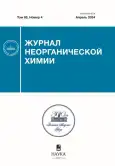Determination Of Optimal Conditions For Template Sol-Gel Synthesis For The Formation Of Antibacterial Materials
- Авторлар: Lantsova E.A.1, Bardina M.A.1, Saverina E.A.1, Kamanina O.A.1
-
Мекемелер:
- Tula State University
- Шығарылым: Том 69, № 4 (2024)
- Беттер: 573-580
- Бөлім: НЕОРГАНИЧЕСКИЕ МАТЕРИАЛЫ И НАНОМАТЕРИАЛЫ
- URL: https://transsyst.ru/0044-457X/article/view/666575
- DOI: https://doi.org/10.31857/S0044457X24040135
- EDN: https://elibrary.ru/ZXRBJF
- ID: 666575
Дәйексөз келтіру
Аннотация
One of the current global problems is the increasing resistance of microorganisms to antibacterial agents and the emergence of associated infections. Therefore, the synthesis of new hybrid materials capable of resisting bacteria is necessary. In this work, loading platforms for antibacterial material based on tetraethoxysilane were formed using yeast cells Ogataea polymorpha BKM Y-2559 and Cryptococcus curvatus VKM Y-3288 as templates under conditions of acid and alkaline hydrolysis. Using scanning electron microscopy, it was shown that an alkaline environment is most optimal when using yeast cells as templates for the formation of a porous material. The surface-active properties of a number of quaternary ammonium compounds were studied using the tensometry method to select the optimal template for the production of antibacterial materials in one stage.
Толық мәтін
Авторлар туралы
E. Lantsova
Tula State University
Хат алмасуға жауапты Автор.
Email: e.a.lantsova@tsu.tula.ru
Ресей, Tula, 300012
M. Bardina
Tula State University
Email: e.a.lantsova@tsu.tula.ru
Ресей, Tula, 300012
E. Saverina
Tula State University
Email: e.a.lantsova@tsu.tula.ru
Ресей, Tula, 300012
O. Kamanina
Tula State University
Email: e.a.lantsova@tsu.tula.ru
Ресей, Tula, 300012
Әдебиет тізімі
- Cámara M., Green W., MacPhee C. et al. // Biofilms Microbiomes. 2022. V. 8. № 1. P. 42. https://doi.org/10.1038/s41522-022-00306-y
- Nadeem S., Gohar U., Tahir S. et al. // Crit. Rev. Microbiol. 2020. V. 46. № 5. P. 578. https://doi.org/10.1080/1040841X.2020.1813687
- Murray C.J.L., Ikuta K.S., Sharara F. et al. // Lancet. 2022. V. 399. № 10325. P. 629. https://doi.org/10.1016/S0140-6736(21)02724-0
- Saverina E.A., Frolov N.A., Kamanina O.A. et al. // ACS Infect. Dis. 2023. V. 9. № 3. P. 394. https://doi.org/10.1021/acsinfecdis.2c00469
- Nielsen J.E., Alford M.A., Yung D.B.Y. et al. // ACS Infect. Dis. 2022. V. 8. № 3. P. 533. https://doi.org/10.1021/acsinfecdis.1c00536
- Song B., Zhang E., Han X. et al. // ACS Appl. Mater. Interfaces. 2020. V. 12. № 19. P. 21330. https://doi.org/10.1021/acsami.9b19992
- Spirescu V.A., Chircov C., Grumezescu A.M. et al. // Int. J. Mol. Sci. 2021. V. 22. № 9. P. 4595. https://doi.org/10.3390/ijms22094595
- Zhang T., Jin Z., Jia Z. et al. // React. Funct. Polym. 2022. V. 170. P. 105117. https://doi.org/10.1016/j.reactfunctpolym.2021.105117
- Ma B., Chen Y., Hu G. et al. // ACS Biomater. Sci. Eng. 2022. V. 8. № 1. P. 109. https://doi.org/10.1021/acsbiomaterials.1c01267
- Alekseeva O.V., Smirnova D.N., Noskov A.V. et al. // Russ. J. Inorg. Chem. 2023. V. 68. № 8. P. 953. https://doi.org/10.1134/S0036023623601071
- Wen M., Fu X., Li T. et al. // Russ. J. Gen. Chem. 2023. V. 93. № 9. P. 2371. https://doi.org/10.1134/S1070363223090189
- Diaz D., Church J., Young M. et al. // J. Environ. Sci. 2019. V. 82. P. 213. https://doi.org/10.1016/j.jes.2019.03.011
- Zhang H., Liu L., Hou P. et al. // Polymers. 2022. V. 14. № 9. P. 1737. https://doi.org/10.3390/polym14091737
- Feng X.Z., Xiao Z., Zhang L. et al. // Nat. Prod. Commun. 2020. V. 15. № 8. P. 1934578X20948365. https://doi.org/10.1177/1934578X20948365
- Garipov M.R., Sabirova A.E., Pavelyev R.S. et al. // Bioorg. Chem. 2020. V. 104. P. 104306. https://doi.org/10.1016/j.bioorg.2020.104306
- Sokolova A.S., Yarovaya O.I., Baranova D.V. et al. // Arch. Virol. 2021. V. 166. № 7. P. 1965. https://doi.org/10.1007/s00705-021-05102-1
- Gaspar C., Rolo J., Cerca N. et al. // Pathogens. 2021. V. 10. № 3. P. 261. https://doi.org/10.3390/pathogens10030261
- Bueno V., Ghoshal S. // Langmuir. 2020. V. 36. № 48. P. 14633. https://doi.org/10.1021/acs.langmuir.0c02501
- Zaharudin N.S., Isa E.D.M., Ahmad H. et al. // J. Saudi Chem. Soc. 2020. V. 24. № 3. P. 289. https://doi.org/10.1016/j.jscs.2020.01.003
- Stewart C.A., Finer Y., Hatton B.D. // Sci. Rep. 2018. V. 8. № 1. P. 1. https://doi.org/10.1038/s41598-018-19166-8
- Hoa B.T., Phuc L.H., Hien N.Q. et al. // Russ. J. Inorg. Chem. 2022. V. 67. № 1. P. 63. https://doi.org/10.1134/S003602362260160X
- Kamanina O.A., Saverina E.A., Rybochkin P.V. et al. // Nanomaterials. 2022. V. 12. № 7. P. 1086. https://doi.org/10.3390/nano12071086
- Dolinina E.S., Parfenyuk E.V. // Russ. J. Inorg. Chem. 2022. V. 67. № 3. P. 401. https://doi.org/10.1134/S0036023622030068
- Voronova M.I., Surov O.V., Rubleva N.V. et al. // Russ. J. Inorg. Chem. 2022. V. 67. № 3. P. 395. https://doi.org/10.1134/S0036023622030159
- Ebrahiminezhad A., Najafipour S., Kouhpayeh A. et al. // Colloids Surf., B: Biointerfaces. 2014. V. 118. P. 249. https://doi.org/10.1016/j.colsurfb.2014.03.052
- Dubovoy V., Ganti A., Zhang T. et al. // J. Am. Chem. Soc. 2018. V. 140. № 42. P. 13534. https://doi.org/10.1021/jacs.8b04843
- Bokov D., Turki Jalil A., Chupradit S. et al. // Adv. Mater. Sci. Eng. 2021. P. 1. https://doi.org/10.1155/2021/5102014
- Yamamoto M., Takami T., Matsumura R. et al. // Biocontrol Sci. Jpn. 2016. V. 21. № 4. P. 231. https://doi.org/10.4265/bio.21.231
- Frolov N.A., Fedoseeva K.A., Hansford K. et al. // ChemMedChem. 2021. V. 16. № 19. P. 2954. https://doi.org/10.1002/cmdc.202100284
- Seferyan M.A., Saverina E.A., Frolov N.A. et al. // ACS Infect. Dis. 2023. V. 9. № 6. P. 1206. https://doi.org/10.1021/acsinfecdis.2c00546
- Xu J., Ren D., Chen N. et al. // Colloids Surf., A: Physicochem. 2021. V. 625. P. 126845. https://doi.org/10.1016/j.colsurfa.2021.126845
- Esmaeili H., Mousavi S.M., Hashemi S.A. et al. Chapter 7 – Application of biosurfactants in the removal of oil from emulsion. Elsevier, 2021. P. 107. https://doi.org/10.1016/B978-0-12-822696-4.00008-5
- Azum N., Alotaibi M.M., Ali M. et al. // J. Mol. Liq. 2023. V. 259. P. 121057. https://doi.org/10.1016/j.molliq.2022.121057
Қосымша файлдар














